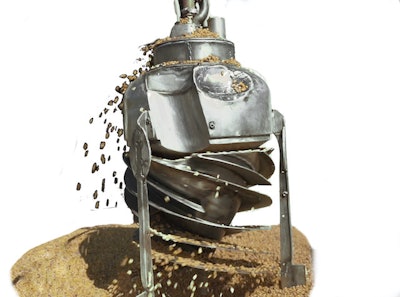
Almost every industry must store bulk materials. At one time or another, this bulk material will form an impenetrable layer called a bridge. This can be a major hazard.
Need and Solution
Every year the ag industry experiences fatalities due to engulfment of workers in grain and feed silos. While “ it can’t happen here," it does.
The silo may have voids, or it may have a bridging situation, and all too often the solution is to put a person into the silo. Now we have gone from “it can’t happen here” to “I hope nothing bad happens. At that point risk is not being managed, hope is being managed. A written policy banning this confined space entry does not keep a person out, it fools management into thinking the risk has been mitigated.
All current methods to solve this problem are sometimes successful. The rate of success varies with who you talk to. The typical price successful or not is about $33,000.
业务,比如糖生产商,也失去了product in the silo as it is contaminated. A customer of ours valued the sugar in the silo at $45,000. An additional cost of eliminating the now waste material will also be a factor.
The worst, but very common, solution is to put a man in the silo. Hopefully, he can break up the bridge but in 2019, 37 farm and agribusiness personnel died in this effort. The last effort is to cut holes in the silo and let the material flow out, then put people in the silo to breakup any overhead buildup. Of course, no one ever gets hit on the head.
Our patented TSS2 is unique. It will dig a large hole through the middle of material until it finds the bridge, which is destroyed by its powerful vibrator. The TSS2 can then grind up any remaining blockage.
If no one enters a bridged silo, if no one tries to walk down the grain, the risk is eliminated. Twenty or thirty times a year the person that enters that silo will not come out. The best way to limit risk is to reduce the chance of injury or death to zero.
切割洞竖井的底部往往是performed in a race to save someone or sadly an effort to find the body. Not to sound mercenary, it is also expensive. The cost of material lost or salvaged is also significant. Finally, if the material in the silo is poorly dried, it becomes its own hazard, either through ammonia build up, or combustion.
How to mitigate all risk? Conversations with many operators and managers say the current choice of mixing or bridge breaking works some of the time. None of the techniques work all of the time. We need a certain repair.
I propose the center piece of such a solution should be our TSS2. It will dig a hole almost 2 feet in diameter. One of our videos shows our TSS2 working in DDG. The vibrator is activated after the bottom augur has partially buried the device. The bridged material collapses in a matter of minutes and rather than creating a 2-foot diameter passage the extent of the collapse is about 8 feet in diameter. Since that time, we have increased the torque from 129 foot pounds to 452 foot pounds. This assures burial of the device. As the TSS2 gets to the bridged section the vibrator will destabilize this structure and collapse the it. No one has been put to risk. The device can dig as deep as needed.
The TSS2 can also work as a mixer. It won’t move wet material far but it should do a decent job of mixing a localized batch of grain to help dry it.
The job isn’t totally done. Eventually a whip will need to be used to remove material from the silo walls. Without the big hole in the middle, you are depending on luck to make a collapse of the bridge.
Before we increased the drive to the higher torque, we were able to dig foxholes about 6 feet in diameter and 3 feet deep in a bean storage silo that was filled with ammonia as the beans fermented for a year. However, the drive then stalled. We don’t expect the upgraded drive to have the same problem. We have another video showing the TSS2 burying itself in a few minutes in corn. If there is a silo that won’t allow the TSS2 to keep on digging, we know that we can “chew up” a massive amount of baked together beans and a vacuum can pull out these loose beans. This will get the job done if needed. We do not expect this to be needed.
How do you mitigate this risk? Keep people out and put a machine in the silo. No entry no risk.
Our patented TSS2 is unique. It will dig a relatively large hole through the middle of material until it finds the bridge, which is destroyed by its powerful vibrator. The TSS2 can then grind up any remaining blockage.
A smaller size will be ideal for farms and farm cooperatives. see this as an aid in loading and unloading for rail, truck and ship unloading applications with products such as DDGs. You won’t even have to beat the outside walls anymore.




